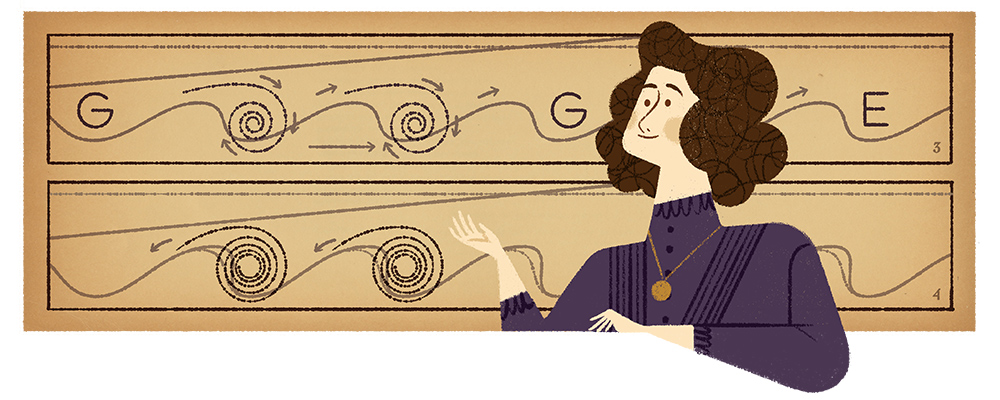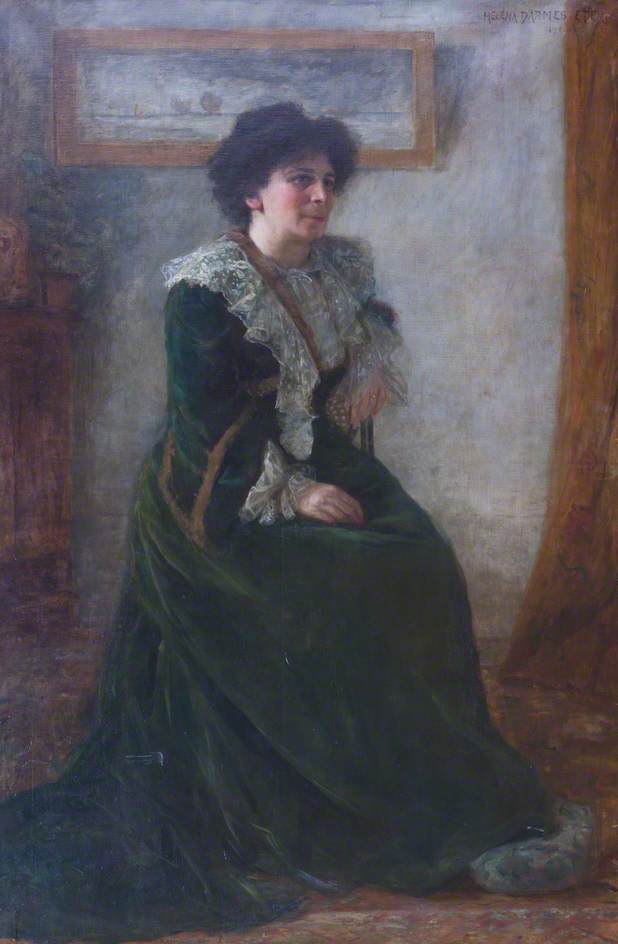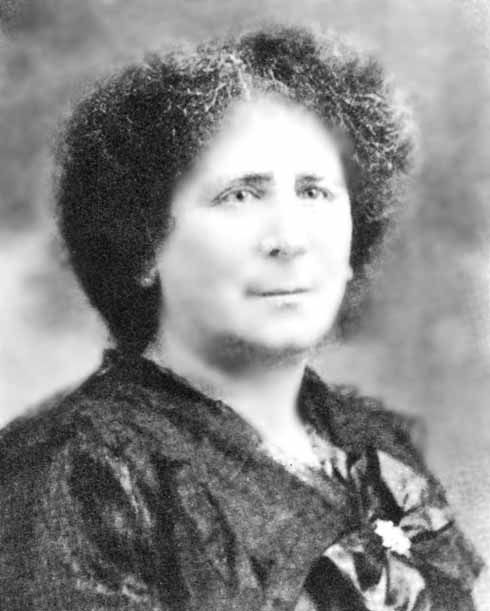
(Lydia Nichols/Google)
Hertha Marks Ayrton, the British inventor, scientist and mathematician, is being celebrated with a Google Doodle on what would have been her 162nd birthday.
“Lydia Nichols’ doodle shows Ayrton framed by her breakthrough findings. Today, 162 years after her birth, we celebrate her legacy as engineer, mathematician, physicist, and inventor, her impact still rippling through the scientific community,” Google says.
Ayrton was born April 28, 1854, and died on August 23, 1923, at the age of 69.
Here’s what you need to know about Hertha Marks Ayrton:
1. She Was Born as the 3rd of 8 Children in Hampshire, England

Hertha Marks Ayrton. (Girton College, University of Cambridge; Supplied by The Public Catalogue Foundation)
Hertha Marks Ayrton was born as Phoebe Sarah Marks, the third child of eight to Levi Marks, a Polish Jewish watchmaker, and Alice Moss, a seamstress, according to her biography on the Agnes Scott College website.
Her father died in 1861, and she was adopted by her aunt at the age of nine.
Ayrton was agnostic. She denounced her Jewish religion and changed her name to Hertha, after the earth goddess featured in Algernon Charles Swineburn’s 1869 anti-religious poem.
2. She Studied Mathematics at Cambridge & the University of London

The home in London where Hertha Marks Ayrton lived. (Wikipedia Commons)
Ayrton studied mathematics at Girton College, Cambridge University according to the Agnes Scott College’s Biography of Women Mathematicians.
Cambridge did not grant degrees to women when she completed her studies in 1880, so she completed an external examination and was awarded a degree from the University of London in 1881.
3. She Became the First Woman to Read Her Own Paper Before the Royal Society, But Was Denied Election as a Fellow
Ayrton published several studies of electrical arcs and became the first woman to read her own paper before the Royal Society, the British learned society for science, in 1904.
When a wave washes over sand, ripples will appear.
This simple observation was a scientific mystery until Hertha Marks Ayrton read ‘The Origin and Growth of Ripple Marks’ to the Royal Society in 1904. She was first woman to do so. Her words were then published, marking a permanent contribution to the canon of physical science and a victory over discrimination and exclusion.
Ayrton was nominated for admission to the prestigious society, but was elected because she was a married woman, according to the Institution of Engineering and Technology:
Her candidature was supported by some notable men of science, but when the council of the Royal Society met to discuss the issue, it was decreed as follows: We are of the opinion that married women are not eligible as Fellows of the Royal Society. Whether the Charters admit of the election of unmarried women appears to us to be very doubtful.
She presented papers before the Royal Society twice more, and was given its Hughes Medal, “for her experimental investigations on the electric arc, and also on sand ripples.” To this day she is only one of only two women to receive the award.
Ayrton was the first woman to be a member of the Institution of Electrical Engineers.
She also fought for other women to receive recognition for their work. After Marie Currie’s husband received credit for the discovery of radium, Ayrton wrote in The Westminster Gazette, “Errors are notoriously hard to kill, but an error that ascribes to a man what was actually the work of a woman has more lives than a cat.”
4. She Invented the Ayrton Fan to Repel Gas Attacks During World War I
In addition to her work on the electric arc and sand ripples, she invented the Ayrton fan, which was used to repel gas attacks during World War I.
The British Army distributed 104,000 of the fans to troops on the Western front, according to the Imperial War Museum:
It was in daily use at the Front since May, 1916; principally for clearing-outs, shell-holes, mine craters, etc., of the foul gases that always accumulate in them under shell fire. These can now be cleared in from a few seconds to a few minutes, and can therefore be consolidated immediately after taking instead of having to be left for hours, and sometimes for days, before they can be entered. They are made of waterproof canvas stiffened with cane, with a wooden handle. The blade has a semi-rigid centre, with loose end and side flaps, and the back has an extra very limited hinge in it to enable it to accomodate itself to the varying shapes of the backs of parapets, corners of traverses etc. They are 3 feet 6 inches long, have a blade 15 inches square, weigh less than 1lb., can be folded and carried in the braces behind the pack.
“At the outbreak of the First World War she began to apply the theories she had developed about oscillations in water to the movement of air. With her habitual practical turn of mind, this was quickly put to use in the invention of the Ayrton Flapper Fan,” the Institution of Engineering and Technology explains. “She encountered some difficulty in getting the military to consider her idea, but her invention was eventually adopted and used to clear the trenches of poisonous gas. After the war, she continued with her work in this field until her death in 1923.”
5. She Was Married & Had a Daughter Who Would Become a Member of Parliament
Hertha Ayrton married physicist and engineer William Edward Ayrton in 1885, according to her biography on the Agnes Scott College’s website. She studied under him and assisted on his research before working on her own projects.
William Ayrton died in 1908 at the age of 61. The couple had a daughter, Barbara Ayrton, who would become a suffragist and a Labour politician who served in the British Parliament from 1945 to 1950.
Barbara Ayrton’s son, Michael Ayrton, was an English writer and artist.


